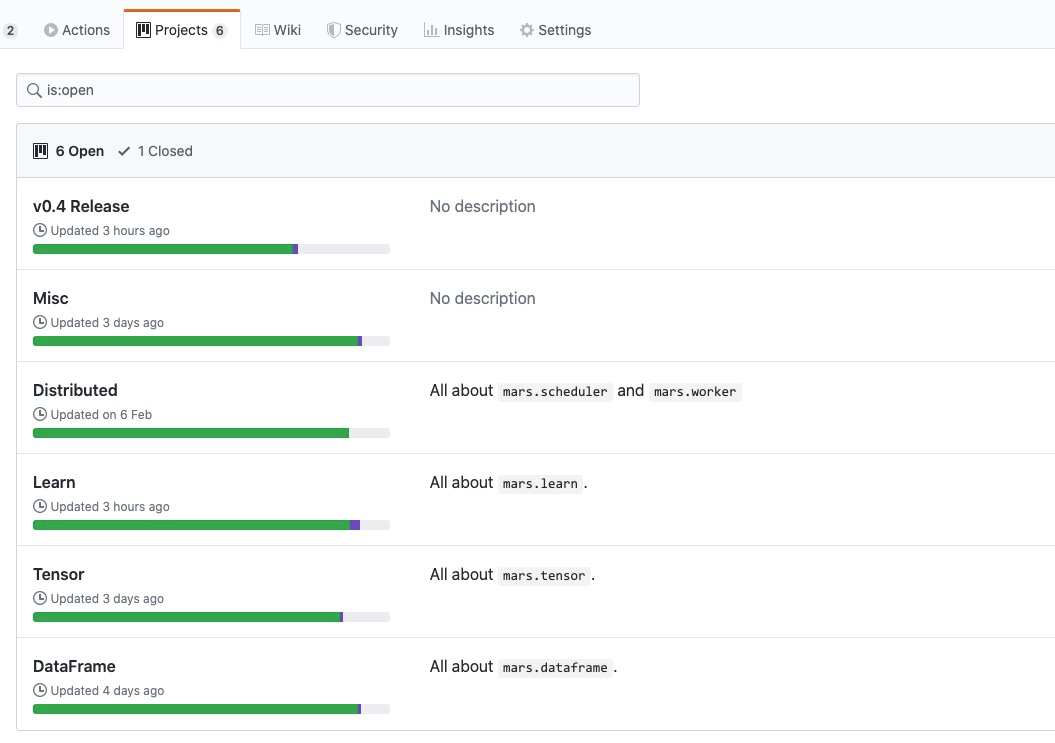This month, Mars released 0.4.0b1 ,0.4.0b2 and 0.3.2 as well as 0.3.3 , click the link to view the detailed Release Notes. The two releases this month are special cases. 0.4.0b2 fixes the more urgent problems in 0.4.0b1.
Mars project release cycle
Here is a brief introduction to the release cycle of Mars. Mars takes one month as the release cycle and adopts the two version release strategy. Generally, both the pre release version and the official version will be released at the same time. More radical features or changes will be included in the pre release version, which may be unstable. In the development, we think that stable features or enhancements will be synchronized to the official version.
See Milestone of Github project You can see the latest pre release and official versions.
See Github Projects page You can see the classified issues and PRs.

v0.4 Release is the issue and PRs in progress that we archive by version. Others are divided by modules.
New version feature Highlight
In the new version, we spent a lot of time to improve the DataFrame API. Through the efforts of this version, some common interfaces in pandas are supported.
Better aggregation and group aggregation
- #1030 Let Groupby.aggregate support multiple aggregate functions.
- #1054 Supports DataFrame.aggregate and Series.aggregate.
- #1019 and #1069 It supports cumulative computation such as cummax.
For example, in pandas, we can movielens data Do the following:
In [1]: import pandas as pd In [2]: %%time ...: df = pd.read_csv('Downloads/ml-20m/ratings.csv') ...: df.groupby('movieId').agg({'rating': ['max', 'min', 'mean', 'std']}) ...: ...: CPU times: user 5.41 s, sys: 1.28 s, total: 6.7 s Wall time: 4.3 s Out[2]: rating max min mean std movieId 1 5.0 0.5 3.921240 0.889012 2 5.0 0.5 3.211977 0.951150 3 5.0 0.5 3.151040 1.006642 4 5.0 0.5 2.861393 1.095702 5 5.0 0.5 3.064592 0.982140 ... ... ... ... ... 131254 4.0 4.0 4.000000 NaN 131256 4.0 4.0 4.000000 NaN 131258 2.5 2.5 2.500000 NaN 131260 3.0 3.0 3.000000 NaN 131262 4.0 4.0 4.000000 NaN [26744 rows x 4 columns]
We aggregate according to the movie ID to get the maximum, minimum, average and standard deviation of user evaluation.
With Mars, you can:
In [1]: import mars.dataframe as md In [2]: %%time ...: df = md.read_csv('Downloads/ml-20m/ratings.csv') ...: df.groupby('movieId').agg({'rating': ['max', 'min', 'mean', 'std']}).execute() ...: ...: CPU times: user 5.81 s, sys: 6.9 s, total: 12.7 s Wall time: 1.54 s Out[2]: rating max min mean std movieId 1 5.0 0.5 3.921240 0.889012 2 5.0 0.5 3.211977 0.951150 3 5.0 0.5 3.151040 1.006642 4 5.0 0.5 2.861393 1.095702 5 5.0 0.5 3.064592 0.982140 ... ... ... ... ... 131254 4.0 4.0 4.000000 NaN 131256 4.0 4.0 4.000000 NaN 131258 2.5 2.5 2.500000 NaN 131260 3.0 3.0 3.000000 NaN 131262 4.0 4.0 4.000000 NaN [26744 rows x 4 columns]
The code is almost identical, except that Mars needs to trigger execution through execute().
ratings.csv has 500M +, which can be accelerated several times by using Mars to run on my laptop. When the amount of data is larger, using Mars can also have better acceleration effect. If a single machine is not competent, you can also use Mars distributed to accelerate execution with consistent code.
sort
Or to movielens data For example.
In [1]: import pandas as pd In [2]: %%time ...: ratings = pd.read_csv('Downloads/ml-20m/ratings.csv') ...: movies = pd.read_csv('Downloads/ml-20m/movies.csv') ...: movie_rating = ratings.groupby('movieId', as_index=False).agg({'rating': 'mean'}) ...: result = movie_rating.merge(movies[['movieId', 'title']], on='movieId') ...: result.sort_values(by='rating', ascending=False) ...: ...: CPU times: user 5.17 s, sys: 1.13 s, total: 6.3 s Wall time: 4.05 s Out[2]: movieId rating title 19152 95517 5.0 Barchester Chronicles, The (1982) 21842 105846 5.0 Only Daughter (2013) 17703 89133 5.0 Boys (Drenge) (1977) 21656 105187 5.0 Linotype: The Film (2012) 21658 105191 5.0 Rocaterrania (2009) ... ... ... ... 26465 129784 0.5 Xuxa in Crystal Moon (1990) 18534 92479 0.5 Kisses for My President (1964) 26475 129834 0.5 Tom and Jerry: The Lost Dragon (2014) 24207 115631 0.5 Alone for Christmas (2013) 25043 119909 0.5 Sharpe's Eagle (1993) [26744 rows x 3 columns]
The main goal is to rank the movies in the dataset from high to low on average.
On Mars' side, the code is almost the same.
In [1]: import mars.dataframe as md In [2]: %%time ...: ratings = md.read_csv('Downloads/ml-20m/ratings.csv') ...: movies = md.read_csv('Downloads/ml-20m/movies.csv') ...: movie_rating = ratings.groupby('movieId', as_index=False).agg({'rating': 'mean'}) ...: result = movie_rating.merge(movies[['movieId', 'title']], on='movieId') ...: result.sort_values(by='rating', ascending=False).execute() ...: ...: CPU times: user 4.97 s, sys: 6.01 s, total: 11 s Wall time: 1.39 s Out[2]: movieId rating title 19152 95517 5.0 Barchester Chronicles, The (1982) 21842 105846 5.0 Only Daughter (2013) 17703 89133 5.0 Boys (Drenge) (1977) 21656 105187 5.0 Linotype: The Film (2012) 21658 105191 5.0 Rocaterrania (2009) ... ... ... ... 26465 129784 0.5 Xuxa in Crystal Moon (1990) 18534 92479 0.5 Kisses for My President (1964) 26475 129834 0.5 Tom and Jerry: The Lost Dragon (2014) 24207 115631 0.5 Alone for Christmas (2013) 25043 119909 0.5 Sharpe's Eagle (1993) [26744 rows x 3 columns]
Mars uses a parallel regular sampling sorting algorithm. In our article( link )It has been introduced in and will not be described here.
Better index support
Mars supported iloc in previous versions, and now we also support other indexing methods.
- #1042 loc is supported in.
- #1101 at and iat are supported in.
- #1073 The md.date.u range method is supported in.
Through the support of loc, it makes the index based data search more convenient.
In [1]: import mars.dataframe as md In [3]: import mars.tensor as mt In [8]: df = md.DataFrame(mt.random.rand(10000, 10), index=md.date_range('2000-1-1', periods=10000)) In [9]: df.loc['2020-3-25'].execute() Out[9]: 0 0.372354 1 0.139235 2 0.511007 3 0.102200 4 0.908454 5 0.144455 6 0.290627 7 0.248334 8 0.912666 9 0.830526 Name: 2020-03-25 00:00:00, dtype: float64
Custom functions, strings, and time handling
- #1038 Added support for apple.
- #1063 md.Series.str and md.Series.dt are supported to handle strings and time columns.
We can use apply to calculate each city( data set )The distance to Hangzhou (120 ° 12'e, 30 ° 16'n).
In [1]: import numpy as np In [2]: def haversine(lat1, lon1, lat2, lon2): ...: dlon = np.radians(lon2 - lon1) ...: dlat = np.radians(lat2 - lat1) ...: a = np.sin(dlat / 2) ** 2 + np.cos(np.radians(lat1)) * np.cos(np.radians(lat2)) * np.sin(dlon / 2) ** 2 ...: c = 2 * np.arcsin(np.sqrt(a)) ...: r = 6371 ...: return c * r ...: In [4]: import mars.dataframe as md In [5]: df = md.read_csv('Downloads/world-cities-database/worldcitiespop.csv', chunk_bytes='16M', dtype={'Region': object} ...: ) In [6]: df.execute(fetch=False) In [8]: df.apply(lambda r: haversine(r['Latitude'], r['Longitude'], 30.25, 120.17), result_type='reduce', axis=1).execute() Out[8]: 0 9789.135208 1 9788.270528 2 9788.270528 3 9788.270528 4 9789.307210 ... 248061 10899.720735 248062 11220.703197 248063 10912.645753 248064 11318.038981 248065 11141.080171 Length: 3173958, dtype: float64
Move window function
- #1045 Added rolling mobile window support.
The mobile window function is frequently used in the financial field. rolling is to perform some aggregation calculation on a fixed length (or a fixed time interval). Here is an example.
In [1]: import pandas_datareader.data as web In [2]: data = web.DataReader("^TWII", "yahoo", "2000-01-01","2020-03-25") In [3]: import mars.dataframe as md In [4]: df = md.DataFrame(data) In [5]: df.rolling(10, min_periods=1).mean().execute() Out[5]: High Low Open Close Volume Adj Close Date 2000-01-04 8803.610352 8642.500000 8644.910156 8756.549805 0.0 8756.517578 2000-01-05 8835.645020 8655.259766 8667.754883 8803.209961 0.0 8803.177734 2000-01-06 8898.426758 8714.809896 8745.356445 8842.816732 0.0 8842.784180 2000-01-07 8909.012451 8720.964844 8772.374756 8844.580078 0.0 8844.547607 2000-01-10 8952.413867 8755.129883 8806.285742 8896.183984 0.0 8896.151172 ... ... ... ... ... ... ... 2020-03-19 10423.317090 10083.132910 10370.730078 10180.533887 4149640.0 10180.533887 2020-03-20 10202.623047 9833.786914 10105.280078 9971.761914 4366130.0 9971.761914 2020-03-23 9983.399023 9611.036914 9885.659082 9763.000977 3990040.0 9763.000977 2020-03-24 9821.716016 9436.392969 9703.275098 9591.208984 3927690.0 9591.208984 2020-03-25 9685.129980 9290.444922 9543.636035 9466.308984 4003760.0 9466.308984 [4974 rows x 6 columns]
Next release plan
The next version will be 0.4.0rc1 and 0.3.4. We will still focus on improving the coverage and performance of the DataFrame API, improving stability, and adding documents.
If you're interested in Mars, you can follow Mars team column , or nail scan QR code to join Mars discussion group.
